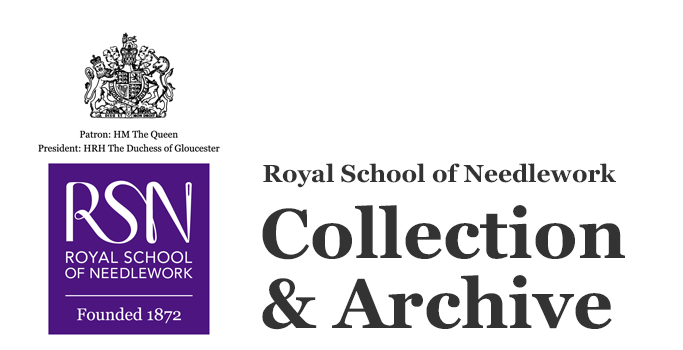Design for front cover of the 1880 'Handbook of Embroidery'
Date
1880
Level of description
Item
Creator
Image, Selwyn (Rev): Selwyn Image (1849–1930), was an Anglican clergyman who became an artist, designer and writer as part of the Arts and Crafts Movement. He later became Professor of Fine Art at Oxford. Image was heavily influenced by William Morris and Burne-Jones. A member of the Art Workers’ Guild he was co-founder, with Arthur Mackmurdo and Herbert Horne, of the Century Guild (1883–92), and was a key contributor to its periodical, The Century Guild Hobby Horse. He worked a great deal with Mackmurdo. He contributed a number of designs to the Royal School of Art Needlework. His work has often been misattributed to others including to Burne-Jones and to Mackmurdo.
Scope and content
Original design for front cover of the 'Handbook of Embroidery' published by the Royal School of Art Needlework, 1880. Pencil on paper with annotations including 'Design for a Book Cover, Selwyn Image' 'March 24 1879'. This was the second version of a cover for this publication, but it was published concurrently in alternative covers. The design shows six pairs of highly stylised 'courting swans' with an intricate background of foliage.
The design sits between the Aesthetic style of his contemporary Walter Crane, seen in items like the Swan, Rush and Iris wallpaper pattern dating from 1875 (V&A), and the bolder proto British Art Nouveau of Arthur Mackmurdo, who was closely associated with Image. It has clarity and complexity and is obviously very influenced by the Arts and Crafts Movement.
This design is a striking vertical and horizontal repeat and features the stylised, medieval influenced, typography typical of Arts and Crafts printing and publications. It reads 'Royal School of Art Needlework' 'Modern Embroidery', this was different from the alternative cover which titles the book 'Handbook of Embroidery'.
Image's book covers often had oblique references to the subject of the books they were intended for. It is unclear what that might be in this case, however the Royal School of Needlework's motto at this time was 'A small bird may fly high'. The Aesthetic movement in general had great sympathy for birds like swans and peacocks and there was a perception that needlework was an ideal medium with which to depict them.
The background foliage as well as the swan shapes show the artists affinity for natural forms which he worked into elegant stylised patterns and are similar in feel to the backgrounds of his designs for the Goddess Screen, also in the Royal School of Needlework's collection (D1/003.a-c).
https://victorianweb.org/art/design/books/cooke25.html
Hulse, Lynn, 'Handbook of Embroidery' introductory essay (2011)
The design sits between the Aesthetic style of his contemporary Walter Crane, seen in items like the Swan, Rush and Iris wallpaper pattern dating from 1875 (V&A), and the bolder proto British Art Nouveau of Arthur Mackmurdo, who was closely associated with Image. It has clarity and complexity and is obviously very influenced by the Arts and Crafts Movement.
This design is a striking vertical and horizontal repeat and features the stylised, medieval influenced, typography typical of Arts and Crafts printing and publications. It reads 'Royal School of Art Needlework' 'Modern Embroidery', this was different from the alternative cover which titles the book 'Handbook of Embroidery'.
Image's book covers often had oblique references to the subject of the books they were intended for. It is unclear what that might be in this case, however the Royal School of Needlework's motto at this time was 'A small bird may fly high'. The Aesthetic movement in general had great sympathy for birds like swans and peacocks and there was a perception that needlework was an ideal medium with which to depict them.
The background foliage as well as the swan shapes show the artists affinity for natural forms which he worked into elegant stylised patterns and are similar in feel to the backgrounds of his designs for the Goddess Screen, also in the Royal School of Needlework's collection (D1/003.a-c).
https://victorianweb.org/art/design/books/cooke25.html
Hulse, Lynn, 'Handbook of Embroidery' introductory essay (2011)
Reference code
MS 589
© Royal School of Needlework
